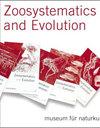来自伊朗的两种栖息于地下水的两足类新物种,属于 Niphargus 属(节肢动物门,甲壳纲)。
IF 1.6
2区 生物学
Q2 ZOOLOGY
引用次数: 0
摘要
在伊朗,埃尔伯兹山脉和扎格罗斯山脉包括大量岩溶地区,其中有许多含水层和地下水资源。Niphargus Schiødte, 1849 是一种种类繁多的地下片脚类动物,栖息于古北界西部的地下水环境中,伊朗是其分布的东部极限。本研究考察了从埃尔伯兹山脉和扎格罗斯山脉的泉水中采集的标本,通过形态观察和利用 COI 和 28S rDNA 基因进行分子分析,揭示了两个不同的分类单元。N.elburzensissp.nov.的特征是外板Ⅰ至Ⅲ产生;吻端叶上端、侧端和中端各有五根刺,吻端叶Ⅱ前端呈矩形,掌角有两根 L-刚毛,上颌Ⅰ外板刺有 2-2-1-1-3-0-1 个小齿。N.zagrosensissp.nov.的区别在于:合趾器 II 的前节呈三角形,围足 VI 长于围足 VII,上颚外板小于上颚第 2 节的一半,泌尿足 III 的远端节超过近端节的 80%。N.elburzensp.nov.与其他物种之间的配对遗传距离为 COI 基因 10.70%(N. fiseri)至 23.48%(N. daniali),28S 基因 1.56%(N. urmiensis)至 10.98%(N. daniali)。此外,N. zagrosensp.nov.的 COI 基因距离为 5.73%(N. alisadri)至 20.66%(N. daniali),28S 基因距离为 0.13%(N. alisadri)至 11.36%(N. daniali)。贝叶斯分析表明,这两个新发现的物种是伊朗当地广阔支系的一部分。高引导值表明,这些物种在系统发育上是独立的。本文章由计算机程序翻译,如有差异,请以英文原文为准。
Two new species of groundwater-inhabiting amphipods belonging to the genus Niphargus (Arthropoda, Crustacea), from Iran
In Iran, the Elburz and Zagros Mountain ranges include substantial karst regions housing numerous aquifers and groundwater resources. Niphargus Schiødte, 1849, a diverse subterranean amphipod genus, inhabits Western Palearctic groundwater environments, with Iran marking the eastern limit of its distribution. This study examined specimens collected from springs along the Elburz and Zagros Mountains, revealing two distinct taxonomic units through a combination of morphological observations and molecular analyses, utilizing COI and 28S rDNA genes. N. elburzensissp. nov. is characterized by produced epimeral plates I to III; a telson lobe with five distal, two lateral, and one mesial spine each, a rectangular shape of gnathopod II propodi with two L-setae on palmar corner and maxilla I outer plate spines with 2-2-1-1-3-0-1 denticles. N. zagrosensissp. nov. is distinguished by a triangular shape gnathopod II propodi, pereopod VI longer than pereopod VII, maxilliped outer plate less than half of palp article 2, and uropod III distal article exceeding 80% of the proximal article. Pairwise genetic distances between N. elburzensissp. nov. and other species ranged from 10.70% (N. fiseri) to 23.48% (N. daniali) for COI gene and 1.56% (N. urmiensis) to 10.98% (N. daniali) for 28S gene. Also, N. zagrosensissp. nov. exhibited COI gene distances from 5.73% (N. alisadri) to 20.66% (N. daniali) and from 0.13% (N. alisadri) to 11.36% (N. daniali) for 28S gene distances. Bayesian analysis suggests that the two newly discovered species are part of the expansive local Iranian clade. These species are supported phylogenetically by separate and independent lineages, as indicated by high bootstrapping values.
求助全文
通过发布文献求助,成功后即可免费获取论文全文。
去求助
来源期刊

Zoosystematics and Evolution
ZOOLOGY-
CiteScore
3.50
自引率
5.00%
发文量
34
审稿时长
16 weeks
期刊介绍:
Zoosystematics and Evolution, formerly Mitteilungen aus dem Museum für Naturkunde in Berlin, is an international, open access, peer-reviewed life science journal devoted to whole-organism biology. It publishes original research and review articles in the field of Metazoan taxonomy, biosystematics, evolution, morphology, development and biogeography at all taxonomic levels. The journal''s scope encompasses primary information from collection-related research, taxonomic descriptions and discoveries, revisions, annotated type catalogues, aspects of the history of science, and contributions on new methods and principles of systematics. Articles whose main topic is ecology, functional anatomy, physiology, or ethology are only acceptable when of systematic or evolutionary relevance and perspective.
 求助内容:
求助内容: 应助结果提醒方式:
应助结果提醒方式:


